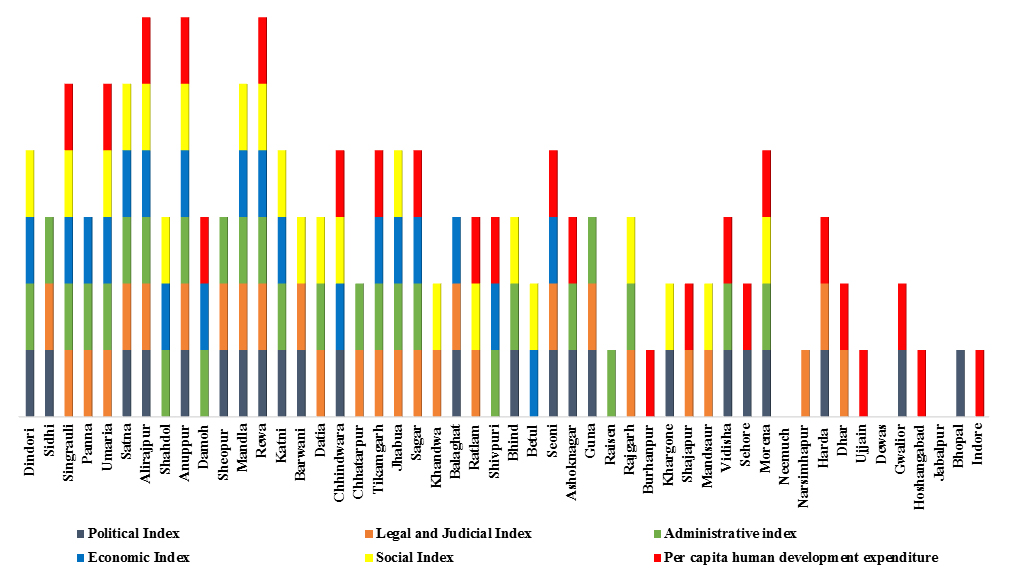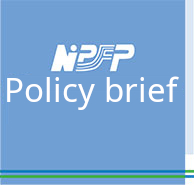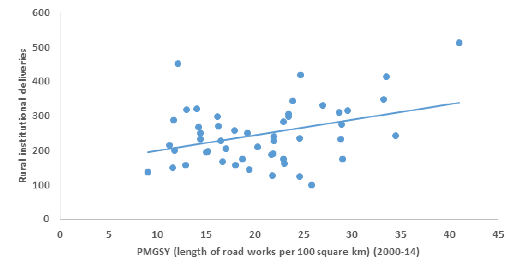Human Development in Madhya Pradesh: the role of fiscal policy and governance
H. K. AMARNATH, Associate Professor, National Institute of Public Finance and Policy, New Delhi, India. email:hk.amarnath@nipfp.org.in
MANISH PRASAD, Research Associate, NIPFP, New Delhi. email:
SHINEY CHAKRABORTY, Research Associate, NIPFP, New Delhi. email:
|
In spite of massive economic growth, Madhya Pradesh has been classified as ‘off-track’ in most of the Millennium Development Goals (MDGs) along with a wide divergence between the growth and human development indicators across different districts within the state.
Divergences in Human development Achievements
At the district level, Dindori, Sidhi, Singrauli, Panna, Umaria are at the bottommost and Indore, Bhopal, Jabalpur, Hoshangabad, Gwalior are the topmost districts in human development achievements. Human development is not only dependent on public expenditure, but also on other factors such as governance. For example the public expenditure on health and health achievements, many districts are performing better in spite of lower expenditures and some are lagging behind even though expenditures are higher.
Level of Achievements in Human Development(%)
 Source: NIPFP-UNICEF (2016) Source: NIPFP-UNICEF (2016)
Health achievements are found to be better in 16 districts in spite of lower per capita expenditures. The districts are Katni, Chhindwara, Seoni, Harda, Sehore, Ratlam, Mandsour, Khargone, Rajgarh, Morena, Dhar, Bhind, Dewas, Betul, Shajapur and Neemuch.
Five districts are lagging behind in health outcomes in spite of higher per capita expenditures. The districts are Shahdol, Sagar, Mandla, Rewa and Raisen. Other 21 districts are lagging behind in health outcomes due to lower expenditures and other reasons.
These trends could suggest that public expenditure alone may not result in better human development outcomes. Sectoral public expenditure could be just a necessary condition and may not be sufficient enough to bring improvements in human development outcomes. In addition to public expenditure, other factors such as governance could also influence the human development.
Divergences in Governance Index
Governance is analyzed through five broad dimensions viz. political, legal & judicial, administrative, economic and social (including environment). Various indicators influencing these dimensions have been used to construct an index for each of these dimensions and by aggregating all these dimensions, District Governance Index is constructed. It is found that there are huge variations across the districts in each of these dimensions. There are some districts, lagging behind in all the dimensions of the governance.
Governance, Public expenditure and Human development Achievement linkages
|
Prioritization of Governance & Public Expenditure in Madhya Pradesh 
Note: Districts are arranged in ascending order based on MDG achievement index taken from NIPFP-UNICEF report, 2016
Impact of PMGSY on Rural Institutional Deliveries in Madhya Pradesh
In Madhya Pradesh, at the district level efficiency of human development expenditure could be improved by improving governance. In understanding what determines performance in education sector, only per capita district domestic product was found to be significant. However, in case of health outcomes, public spending along with governance was found to be significant in achieving health outcomes.
Thus, it suggests that at the district level, Madhya Pradesh government should focus not only on increasing public spending, but also on improving the quality of governance that could enhance the efficiency of public expenditure.
References:
DARPP. (2009), State of Governance- A Framework for Assessment. New Delhi: Department of Administrative Reforms, Public Grievances and Pensions, Government of India.
NIPFP-UNICEF. (2016), Madhya Pradesh State MDG Report 2014-15. New Delhi: National Institute of Public Finance and Policy.
Raikumar, A.S. and Swaroop, V. (2008), “Public spending and outcomes: Does governance matter?” Journal of Development Economics, 86(96–111)
|
1This One pager is an outcome of the detailed technical analysis, “Divergences in Human Development Outcomes in Madhya Pradesh: The role of Fiscal Policy and Governance”, carried out at NIPFP, New Delhi with the financial support from UNICEF, Bhopal.




